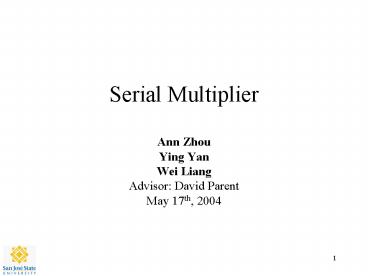Serial Multiplier - PowerPoint PPT Presentation
1 / 18
Title:
Serial Multiplier
Description:
We designed a 5-bit serial multiplier that operated at 200 MHz and used 3.8W/cm2 ... Verilog Waveform and Testbench. Final layout. Verification (DRC and LVS) ... – PowerPoint PPT presentation
Number of Views:526
Avg rating:3.0/5.0
Title: Serial Multiplier
1
Serial Multiplier
- Ann Zhou
- Ying Yan
- Wei Liang
- Advisor David Parent
- May 17th, 2004
2
Agenda
- Abstract
- Introduction
- Why
- Simple Theory
- Back Ground information (Lit Review)
- Summary of Results
- Project (Experimental) Details
- Results
- Cost Analysis
- Conclusions
3
Abstract
- We designed a 5-bit serial multiplier that
operated at 200 MHz and used 3.8W/cm2 of Power
and occupied an area of 767x189mm2 - 3.8W/cm2, no cooling is needed
4
Introduction
- Advantages over equivalent parallel multiplier
- Huge reduction in the required hardware
- in applications where high data rates are not
necessary - Reduce input and output routing
5
Serial multiplier schematic
6
Project Details
- Hand calculations for the longest path
- Final schematic
- Verilog Waveform and Testbench
- Final layout
- Verification (DRC and LVS)
- Final simulation (post extracted)
7
Longest Path Calculations
Note All widths are in microns and capacitances
in fF
8
One Bit Schematic
9
Schematic
10
Verilog Testbench
11
Verilog waveform
12
Layout
13
Verification
14
Simulations
15
Cost Analysis
- Estimate the time we spent on each phase of the
project - verifying logic (four weeks)
- verifying timing (one week)
- layout (two weeks)
- post extracted timing (one week)
16
Lessons Learned
- Verify the logic of the design before layout
- Plan the cell height
- Avoid using metal3 to route power and ground
17
Summary
- We designed a 5-bit serial multiplier that
operated at 200 MHz and used 3.8W/cm2 of Power
and occupied an area of 767x189mm2 - Compared with equivalent parallel multiplier, our
design saved a lot of hardware and area in
applications not requiring very high data rates.
18
Acknowledgements
- Thanks to Cadence Design Systems for the VLSI lab
- Thanks to Synopsys for Software donation
- Thanks to Professor D.Parent
- Thanks to our EE166 classmates































